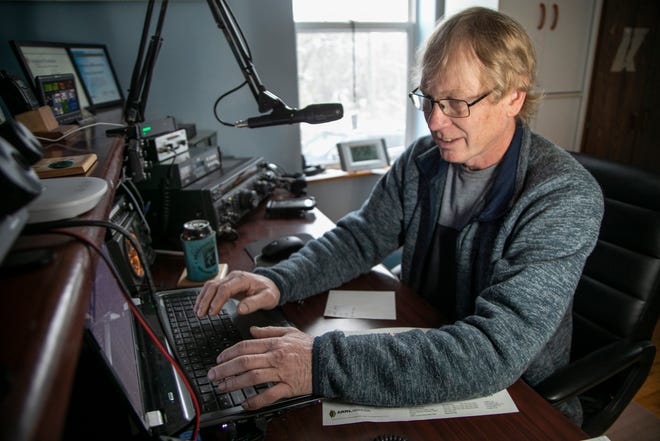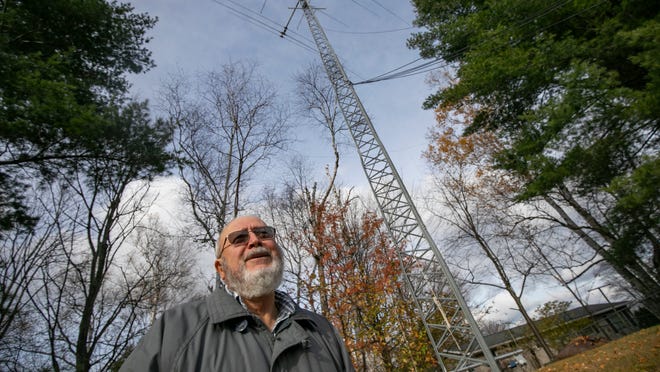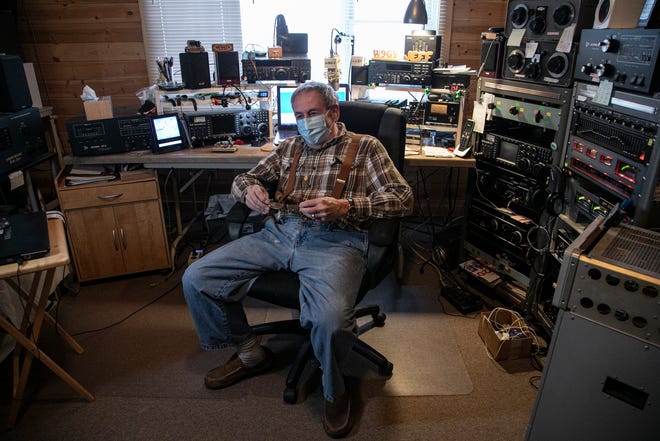In quiet, remote U.P., ham radio helps Michiganders connect from confines of home
Thanks to the lockdowns, ham radio is drawing renewed interest
ALLOUEZ – At first glance, the excitement of the ham radio contest that William LaBell was taking part in wasn’t obvious. There was much attentive sitting. The occasional twist of a knob. A bit of staring at an electronic readout. Ears cocked toward a sonic blanket of hiss washing out of a speaker. Occasionally, he’d even cross his legs.
But for amateur radio operators like him, this was a big day.
LaBell sat at his desk inside his Upper Peninsula home in front of a high-tech array of transceivers, speakers, wires and blinking indicators, trying to fish a voice out of the static. Now and then, the sound of someone reciting a strange combination of letters and numbers emerged from the void, and LaBell had another score for the contest.
“I got 65 contacts now, which is good for me,” said the 57-year-old president of the Keweenaw County Repeater Association, a group of ham radio enthusiasts in the northern Upper Peninsula. Like thousands of other “hams,” as they’re called, he was part of a worldwide competition to see how many people, in how many different countries, they could find to say hello to in the course of the weekend. The winner gets a certificate.
 LaBell grew up Downriver, moved nearly three decades ago to a hilltop home along a dirt road in one of the remotest parts of the remote U.P., and discovered that using ham radio up here was sometimes the only way to find a friendly voice to break the loneliness.
LaBell grew up Downriver, moved nearly three decades ago to a hilltop home along a dirt road in one of the remotest parts of the remote U.P., and discovered that using ham radio up here was sometimes the only way to find a friendly voice to break the loneliness.
“Moving up here and not knowing anybody, I had very few friends,” he said. “But once I got into ham radio, I have a lot more friends; close friends, too. We all help each other out. They’re all a group of great guys, they’ll do anything for you.”
In a place like the Upper Peninsula, where many people live in remote wilderness, where spotty cellphone service magnifies that isolation, and where winter weather can leave people stranded, ham radio is still essential. It’s used for search and rescue, for those times when fallen phone and power lines bring down all other communications, and for events where other methods won’t do, like the region’s annual dogsled race. “When all else fails, ham radio works” is the unofficial motto of amateur radio enthusiasts.
But above all, there’s still the mystery of who’s waiting out there in the static, and the thrill of finding a stranger lurking within the meaningless noise, bringing a greeting from someplace in the distance.
“I like the idea of talking on the other side of the world, thousands of miles away,” LaBell said. “That’s what grabbed me. It’s really cool that you can pick up a microphone and talk to somebody 2,000, 3,000, 5,000 miles away that you’ll probably never meet.”
***
Ham radio is as old as radio itself. It began more than a century ago with the use of Morse code, a system of dots and dashes representing numbers and letters that predated the ability to transmit voices along electrical wires and gave people a way to talk over long distances. To this day, some purists rely on Morse more than voice, and a few hams are able to translate the code into words just by listening to the beeps.
The name “ham” radio was originally an insult hurled by self-regarding telegraph operators who looked down on amateur operators as ham-fisted in their use of Morse code compared with a telegrapher’s nimble fingers. Like a lot of insults, the group it targeted adopted it as their own, and the name has stuck.
At first, it was so popular that amateurs began clogging the commercial and military users right out of the airwaves, and soon came licenses and regulations restricting hams to a narrow band of the spectrum, which gets gradually whittled away every time a new technology demands more bandwidth.
Their setups have become considerably more high-tech in recent years, with computers woven into the mix, allowing users to see a photo and map location for the person they’re talking to. “That’s apparently José in Brazil,” LaBell said, as a thumbnail profile picture popped up on his computer to match the accented voice coming from the speaker. Another score.
For amateurs like him, making contact with someone in exotic locations, like Antarctica, is its own prize. Some bounce signals off the moon and back just because it’s cool to bounce things off the moon. LaBell once even talked briefly with the astronauts on the International Space Station, all of whom are amateur radio operators back home.
 To become a ham, you have to get the sometimes costly equipment and learn how to maintain, repair and configure it. Then you have to pass a test and earn a license from the Federal Communications Commission. Each operator is assigned a call sign, which is a unique combination of letters and numbers that indicates roughly where they’re located and the range of frequencies they’re allowed to work, depending on their level of licensing.
To become a ham, you have to get the sometimes costly equipment and learn how to maintain, repair and configure it. Then you have to pass a test and earn a license from the Federal Communications Commission. Each operator is assigned a call sign, which is a unique combination of letters and numbers that indicates roughly where they’re located and the range of frequencies they’re allowed to work, depending on their level of licensing.
There are currently about 770,000 licensed operators in America, with around 3 million worldwide. In Michigan, the number is around 21,000.
Some get into it just for the fun of tinkering with the gadgetry. Others are drawn to its search-and-rescue aspect, especially in areas like the Upper Peninsula, where amateur radio operators are often enlisted to find stray hikers and lost hunters in the deep wilderness, and where nearly all county emergency operations centers have a ham radio setup in their buildings, just in case. A few hams are preppers, convinced they’ll be kings of communication if everything hits the fan, since amateur radios can operate by battery. And ham radio has proven essential during disasters, as when Hurricane Maria destroyed much of the infrastructure in Puerto Rico three years ago, and amateur radio was the only way to reach people on the island.
For a lot of people, though, it’s a way to connect with other human beings when doing so in person is impossible.
“It’s getting to meet a lot of different people that you might not cross paths with otherwise,” said Andy Larsen of Skandia, the 49-year-old frequency coordinator with the Upper Peninsula Amateur Radio Repeater Association, who’s also known as KB8PPE. “Just the fact that you can get on a radio and talk to somebody, even if you don’t have cellphone coverage, you can talk to somebody you don’t even know by picking up your microphone and putting out your call. And you might talk to somebody you might never meet or might never know.”
Thanks to the pandemic, there’s been a surge of interest everywhere among people confined to their homes, seeking a sense of fellowship and community. HamRadioPrep.com, a website that streamlines training for the FCC exams, says the number of people in the U.S. signing up for courses went up 700% once the pandemic hit. The FCC also noted an increase in licenses granted beginning in March, when the lockdowns started.
“I think people finally had time to do the studying, and that maybe their lives were so wound up before that they couldn’t take the time to do it,” said LaBell, call sign KD8JAM. “There’s been a surge in it, and the numbers are coming up.”
 Bob Inderbitzen (NQ1R), spokesman for the American Radio Relay League, a national organization that promotes and advocates ham radio, has seen the increase himself. “We’ve definitely seen an uptick in on-air activity. There’s always been a general sense of personal readiness, and amateur radio has played a big part, where ham radio operators have been saying that you never know when you’re going to be disconnected from the world for any number of reasons. And they’ve demonstrated with a radio and a wire that you can still communicate locally, nationally and around the world.”
Bob Inderbitzen (NQ1R), spokesman for the American Radio Relay League, a national organization that promotes and advocates ham radio, has seen the increase himself. “We’ve definitely seen an uptick in on-air activity. There’s always been a general sense of personal readiness, and amateur radio has played a big part, where ham radio operators have been saying that you never know when you’re going to be disconnected from the world for any number of reasons. And they’ve demonstrated with a radio and a wire that you can still communicate locally, nationally and around the world.”
But many hams really just like having conversations with people they’d otherwise never encounter.
“A lot of these guys do like to rack up contacts on the computer screen, and you say, ‘I made a contact.’ Well, what did you do? You just saw something on the screen,” said 83-year-old Lucille Scotty (KD8PTE), 83, of Harvey, who took up the hobby just nine years ago. “I want to talk to someone — What’s their background? How are they doing? What’s the weather like?”
Don LaFreniere (W8PSP) met his wife of 22 years over amateur radio when they were teenagers. Now their 15-year-old son is a ham, too.
“I’ve been doing this for 27 years now, and every time I get on the radio and I reach out and contact somebody in some weird, remote place — like I talked to a guy the other day in Namibia — it’s fascinating to me that with a little piece of wire and a radio I can talk to someone that far away like they are right next to me,” said LaFreniere, 42, of Hancock. “It still has that charm. The magic is still there, ‘cause you still get that euphoric moment when you see someone’s call sign from really far away, or remote, or exotic.”
***
A few miles up the road from LaBell’s house, Jeff Stricker sat at a long desk in his radio room, at the helm of an array of humming equipment, next to a window with a view of the quiet, snowy woods, framed by walls of knotty pine. Like a spaceship inside a cabin.
“This is all my junk!” he said, proudly.
 He’s been a ham radio operator for 50 years. Some days, the 73-year-old spends up to eight hours at his desk, tinkering and talking, sometimes deciphering Morse code messages by ear.
He’s been a ham radio operator for 50 years. Some days, the 73-year-old spends up to eight hours at his desk, tinkering and talking, sometimes deciphering Morse code messages by ear.
“I lived with my grandparents when I was a kid, and my grandfather had a big old console radio; and I think as a boy they put me in a little baby thing in the room where the radio was, and I can remember the tubes shining off the wall and I thought, ‘How the heck does all this work?’ ” said Stricker, (W9GY). “I was just a little kid, but I think I’ve been interested in radio since.”
Back then, hams would take pride in being able to talk to someone in forbidden places behind the Iron Curtain, like the Soviets. “There was no law against it,” he said. “The only country that was forbidden was North Vietnam back then, when the Vietnam War was going on.” He once talked to King Hussein of Jordan, a famous ham operator.
His tech-crowded desk is flanked by stacks of modern radio equipment, beeping and blinking at all hours with activity from the airwaves, offering an aural sea of conversations from which to fish for new friends. But he still has a fondness for the old gadgets, the kind that demanded knowledge and skill to operate, before computers created countless shortcuts, bypassing the satisfaction of finding someone on your own. His ham room is like a museum of radio history, with cabinets and displays showing old car stereos, transistor radios and antique keyers, which were used to tap out messages in Morse code.
 “I’m getting to the point where the technology is escaping me and the parts are getting too small for me to work with,” he admitted. “See, to make these little computers now they got chip components, and I’m used to resistors that you can hold in your hand and radio parts like that. We used computers at work over the years, but there’s a lot of stuff out there nowadays that’s kind of hard to comprehend. If a lot of this stuff goes down, I might not be able to repair it.”
“I’m getting to the point where the technology is escaping me and the parts are getting too small for me to work with,” he admitted. “See, to make these little computers now they got chip components, and I’m used to resistors that you can hold in your hand and radio parts like that. We used computers at work over the years, but there’s a lot of stuff out there nowadays that’s kind of hard to comprehend. If a lot of this stuff goes down, I might not be able to repair it.”
A former auto radio designer for General Motors when he lived in Detroit years ago, he’s the guy who invented Speed Sensitive Volume Control, the function in everyone’s car that makes the stereo’s volume get louder the faster the car is going. “I used to drive with my window down and I couldn’t hear the radio,” he explained. For him, the rigging of the electronics was the appeal of amateur radio, the ability to cross wires and point antennas and draw a voice out of thin air.
In an era of high-tech communications, when nearly everyone has a cellphone, when the Internet makes contact with someone half a world away seem like nothing special, ham radio might seem like an archaic relic, like horseback riding in an age of autos, or sailing in a world of powerboats.
But hams will note that just like with horseback riding or sailing, there’s fun in mastering something that’s not so easy and convenient. That having an uncommon hobby shared by others offers a sense of belonging to a community. That while every other method of communication is dependent on someone else’s wires or satellites, two people with ham radios can still talk to each other, regardless of what might happen in the world around them.
Not surprisingly, getting younger recruits interested is a challenge. Hams tend to skew male, and they tend to be older. “I think there’s a lot of younger people that are just too busy and everybody is glued to their cellphone these days, so there’s some ways it seems maybe less interesting to younger folks,” Larsen said.
Edward Engleman (KG8CX) of Menominee is involved with his local Boys and Girls Club’s efforts to promote ham radio to kids, and admits it can be a hard sell in a world of more flashy high-tech options. “I would say that has probably been a factor in not having as many kids get involved as there used to be back in the ‘30s, ‘40s, ‘50s,” said the 81-year-old. “Before we had all this technology, you’d have many more youngsters get interested in radio.”
But there’s a timeless appeal, he said, in finding out about other parts of the world on your own; in talking to people unfiltered; in simply connecting with someone different that you’d otherwise never encounter, especially in a small town like his. “You find out about the customs and life in certain states and countries, and I think that helps out, too, especially the youngsters learning about things from other countries and other youngsters exchanging ideas.”
Stricker is convinced that ham radio will persevere no matter how many other communication options are invented. “I think as we move along, we will move into higher and higher technology, but still use radio. I think radio is gonna be here for our lifetimes. Nobody’s invented anything better.”
Plus, for those cooped up at home right now thanks to the pandemic winter, it remains one of the few safe ways to make contact with other human beings. No matter how far away they are in their shared isolation, their radios ensure that hams are never truly alone.
“It’s really kind of kept me from going nuts since March. I can sit here and talk to people and I don’t have to worry about wearing a mask,” Stricker said. “It’s the ultimate in social distancing.”
John Carlisle writes about people and places in Michigan. His stories can be found at freep.com/carlisle. Contact him: jcarlisle@freepress.com. Follow him on Twitter @_johncarlisle, Facebook at johncarlisle.freep or on Instagram at johncarlislefreep.
